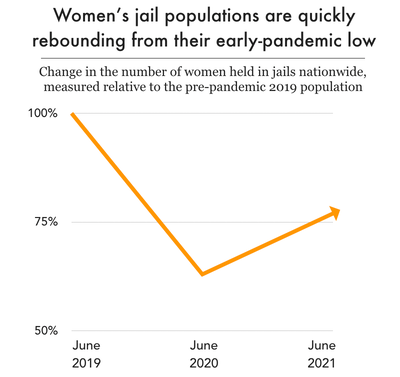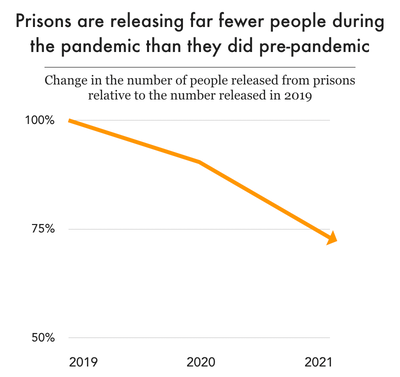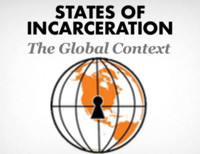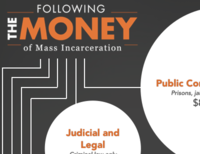This report is old. See our new version.
Women’s Mass Incarceration:
The Whole Pie 2023
By Aleks Kajstura and Wendy Sawyer
March 1, 2023
Press release
With growing public attention to the problem of mass incarceration, people want to know about women’s experiences with incarceration. How many women are held in prisons, jails, and other correctional facilities in the United States? Why are they there? How are their experiences different from men’s? Further, how has the COVID-19 pandemic changed the number of women behind bars? These are important questions, but finding those answers requires not only disentangling the country’s decentralized and overlapping criminal legal systems,1 but also unearthing the frustratingly limited data that’s broken down by gender.2
This report provides a detailed view of the 172,700 women and girls incarcerated in the United States, and how they fit into the even broader picture of correctional control. We pull together data from a number of government agencies and break down the number of women and girls held by each correctional system by specific offense. In this updated report, we’ve also gone beyond the numbers, using rare self-reported data from a national survey of people in prison,3 to offer new insights about incarcerated women’s backgrounds, families, health, and experiences in prison. This report, produced in collaboration with the ACLU’s Campaign for Smart Justice, answers the questions of why and where women are locked up — and so much more:
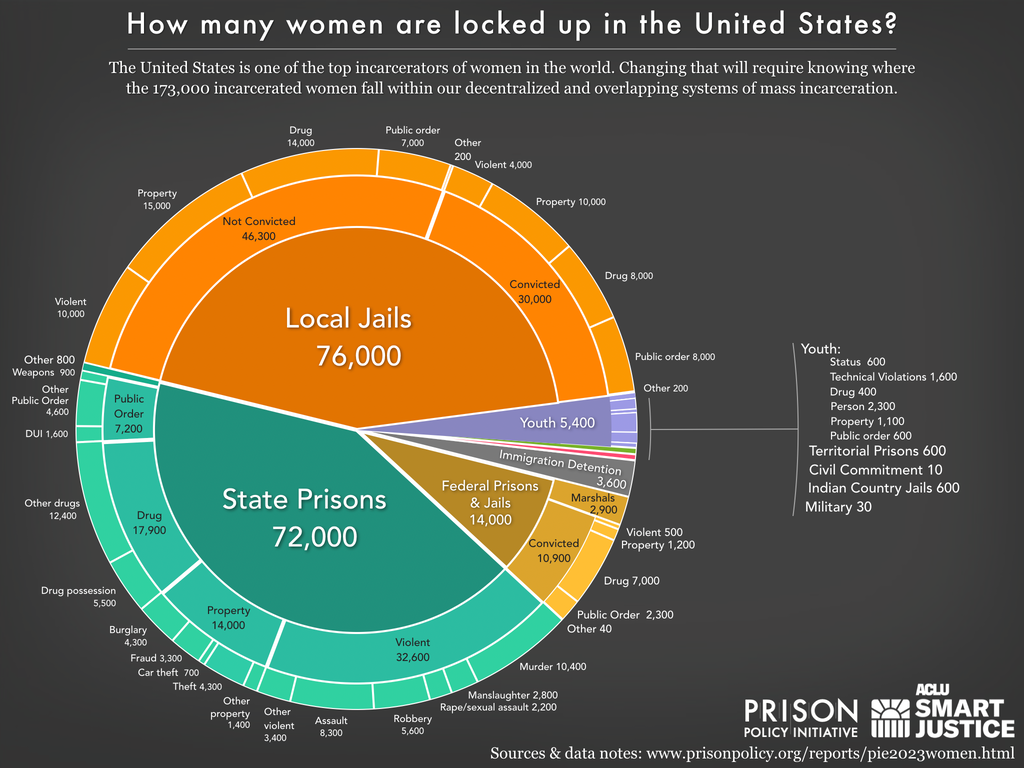
Most notably, and in stark contrast to the total incarcerated population, where the state prison systems hold twice as many people as are held in jails, more incarcerated women are held in jails than in state prisons. As we will explain, the outsized role of jails has serious consequences for incarcerated women and their families.
Women’s incarceration has grown at twice the pace of men’s incarceration in recent decades, and has disproportionately been located in local jails. The data needed to explain exactly what happened, when, and why do not yet exist, not least because the data on women has long been obscured by the larger scale of men’s incarceration. Frustratingly, even as this report is updated using the same data sources from year to year, it is not a direct tool for tracking changes in women’s incarceration over time because we are forced to rely on the limited sources available, which are neither updated regularly nor always compatible across years.
Particularly in light of the scarcity of gender-specific data, the disaggregated numbers presented here are an important step to ensuring that women are not left behind in the effort to end mass incarceration.4
Jails loom large in women’s incarceration
A staggering number of women who are incarcerated are not even convicted: more than a quarter of women who are behind bars have not yet had a trial. Moreover, 60% of women in jails under local control have not been convicted of a crime and are awaiting trial.
Aside from women under local authority (or jurisdiction), state and federal agencies also pay local jails to house an additional 8,875 women. For example, ICE and the U.S. Marshals Service, which have fewer dedicated facilities for their detainees, contract with local jails to hold roughly 3,200 women. So, the number of women physically held in jails is even higher:
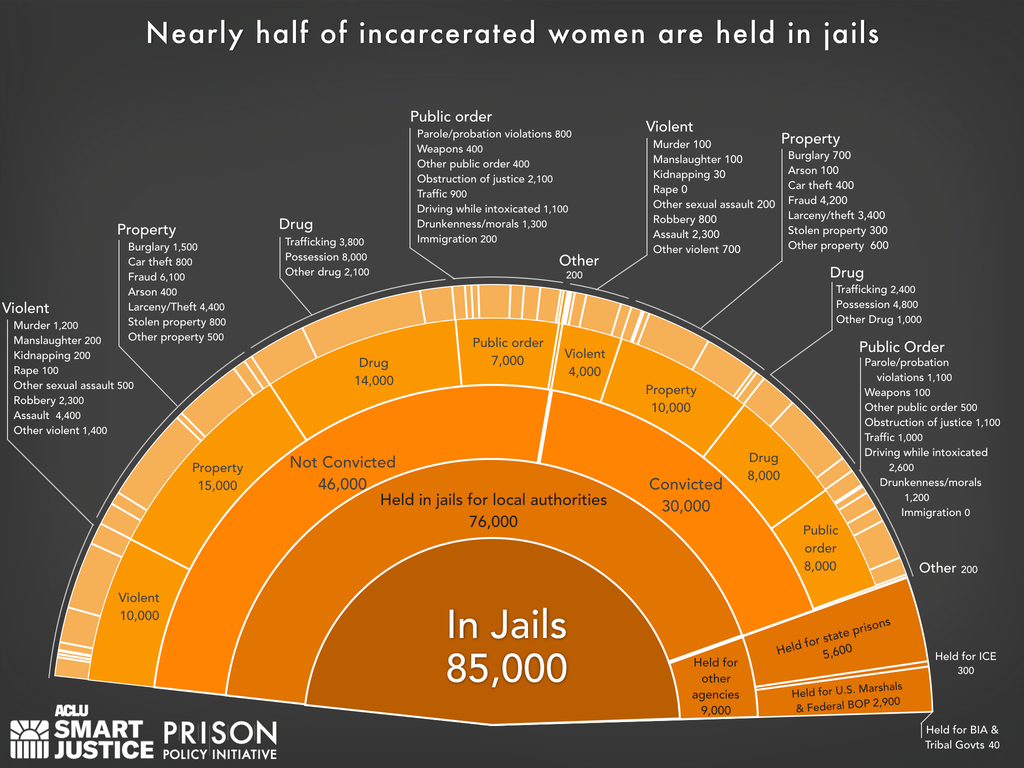
Women disproportionately stuck in jails: Causes and effects
Avoiding pretrial detention is particularly challenging for women. The number of unconvicted women stuck in jail is surely not because courts are considering women to be a flight risk, particularly when they are generally the primary caregivers of children. The far more likely answer is that incarcerated women, who have lower incomes than incarcerated men, have an even harder time affording money bail. When the typical bail amounts to a full year’s income for women,5 it’s no wonder that women are stuck in jail awaiting trial.6
Even once convicted, the system funnels women into jails: About a quarter of convicted incarcerated women are held in jails, compared to about 10% of all people incarcerated with a conviction. This reflects the different distribution of offense types and criminal histories between convicted men and women. Women are proportionally more likely to be serving a sentence of incarceration for a property or drug offense and less likely to be incarcerated for a violent offense when compared to men. These differences mean that women are more likely to be sentenced to a term in jail, where people typically serve shorter sentences of up to one year.7
So, what does it mean that large numbers of women are held in jail — for them, and for their families? First, while stays in jail are generally shorter than in stays in prison, jails can be especially deadly for women. Women have a higher mortality rate than men in jails, dying of drug and alcohol intoxication at twice the rate of men. And the number of deaths by suicide among women in jails increased by almost 65% between the periods of 2000-2004 and 2015-2019. Women are more likely than men to enter jail with a medical problem or a serious mental illness and while incarcerated, women are more likely to suffer from mental health problems and experience serious psychological distress.8 Being locked up doesn’t help: Research shows that incarceration can cause lasting damage to mental health.
Compounding the problem is the fact that jails are particularly poorly positioned to provide proper health care. In fact, local jails tend to offer fewer services and programs overall than prisons do, and because most programs are designed for the larger male population, women may not even have access to programming that’s available to men in the same jail. (However, this is certainly not to say that prisons are always better at meeting women’s needs, as we will discuss further.)
Jails also make it harder to stay in touch with family than prisons do. Jail phone calls are often at least three times as expensive as calls from prison, and other forms of communication are more restricted — some jails don’t even allow real letters, limiting mail to postcards. Increasingly, both prisons and jails are doing away with real mail altogether and contracting with private companies that scan and then destroy postal mail, delivering shoddy scanned copies to the recipients. These barriers to authentic communication are especially troubling given that 80% of women in jails are mothers, and most of them are primary caretakers of their children. Thus children are particularly susceptible to the domino effect of burdens placed on incarcerated women.
Ending mass incarceration requires looking at all offenses — and all women
The numbers revealed by this report enable a national conversation about policies that impact women incarcerated by different government agencies and in different types of facilities. These figures also serve as the foundation for reforming the policies that lead to incarcerating women in the first place.
Too often, the conversation about criminal justice reform starts and stops with the question of “non-violent” drug and property offenses. While drug and property offenses make up more than half of the offenses for which women are incarcerated, the chart reveals that all offenses — including the violent offenses that account for over a quarter of all incarcerated women — must be considered in the effort to reduce the number of incarcerated women in this country. This fact underscores the need for reform discussions to focus not just on the easier choices but on the policy changes that will have the most impact.
Furthermore, even among women, incarceration is not indiscriminate and reforms should address the disparities related to LBTQ status, race, and ethnicity as well. A 2017 study revealed that a third of incarcerated women identify as lesbian or bisexual,9 compared to less than 10% of men. The same study found that lesbian and bisexual women are likely to receive longer sentences than their heterosexual peers, and more likely to be put into solitary confinement.
And although the data do not exist to break down the “whole pie” by race or ethnicity, overall Black and American Indian/Alaska Native women are markedly overrepresented in prisons and jails: Incarcerated women are 53% white, 29% Black, 14% Hispanic, 2.5% American Indian or Alaska Native, 0.9% Asian, and 0.4% Native Hawaiian and Pacific Islander.10 While we are a long way from having data on intersectional impacts of sexuality and race or ethnicity on women’s likelihood of incarceration, it is clear that Black and lesbian or bisexual women and girls are disproportionately subject to incarceration.11
Mass incarceration targets girls, too
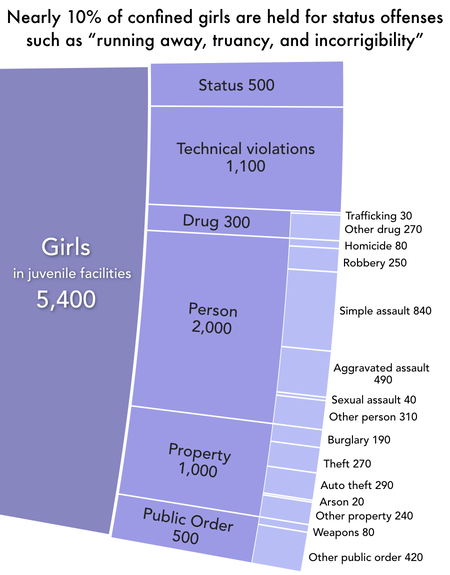
Of the girls confined in youth facilities, nearly 1 in 10 are held for status offenses, such as “running away, truancy, and incorrigibility.” Among boys, status offenses account for just 3% of the confined population. These statistics are particularly troubling because status offenses tend to be simply responses to abuse.12
As is the case with women, girls of color and those who identify as LBTQ are disproportionately confined in juvenile facilities. Black girls account for 35% of the confined girls population, and Hispanic girls account for another 20%, while white girls are only 38% of those locked up. And while LBTQ women overrepresented in the adult correctional systems, a staggering 40% of girls in the juvenile justice system are lesbian, bisexual, or questioning and gender non-conforming. (The comparable statistic for boys is just under 14%.)
While society and the criminal legal systems subject all girls to stricter codes of conduct than is expected of their male peers, Black girls in particular shoulder an added burden of adultification — being perceived as older, more culpable, and more responsible than their peers — which leads to greater contact with and harsher consequences within the juvenile justice system.
Prison is no answer for marginalized, traumatized women
About half of confined women and girls are held in state and federal prisons. In general, women in prison are serving longer sentences than those in jails, and they are often located far from their families and friends. Even in geographically large states like Montana and Arizona, sometimes there is just one facility for women, making visits difficult for loved ones located hundreds of miles away.13 But this is just one of the many challenges facing women in prison, as we recently found in our analysis of a rich dataset published by the Bureau of Justice Statistics, the 2016 Survey of Prison Inmates.14
The data from the survey, published in late 2020, offer a rare in-depth look at the backgrounds and experiences of people in prison, relying on responses from incarcerated people themselves, rather than the administrative data that’s easier to collect from prison systems. In our analysis, we focused on people held in state prisons, who make up a much larger piece of the “whole pie” than those in federal prisons. Among our findings, and those of the Bureau of Justice Statistics, we see that in state prisons nationwide:15
- Women report childhood disadvantages at alarming rates: 12% report homelessness before they turned 18; 19% were in foster care at some point; and 43% came from families that received welfare or other public assistance. Almost half (45%) had been arrested by age 18.
- Women are more likely than men to enter prison having already received a high school diploma or equivalent credential, but still over half (53%) did not finish high school.
- Over a quarter of women (26%) experienced homelessness in the year before the arrest that led to their incarceration — a higher rate than among men (16%).
- Women are more likely to be jobless (53%) than to be employed in the month before their arrest.
- Women are more likely to be written up for a prison rule violation in the past year (58%), particularly for “minor” rule violations.
- Women report disabilities (50%) and physical and mental health problems at higher rates than men. Over half (58%) of women met the criteria for a substance use disorder the year before they went to prison, and over three-quarters (76%) had some indication of a past or current mental health problem — both significantly higher rates than among men. Yet just 47% had received treatment for a substance use disorder and just 43% had received professional mental health care since they went to prison.
- Women are more likely to be parents of minor children (58%), more likely to be single parents, and more likely to have been living with their children prior to their imprisonment — making it more likely that incarceration would uproot their children and lead to termination of parental rights, permanently breaking up their families.
- About 4% of women (over 3,000) were pregnant when they went to prison, and more than two-thirds (68%) of these women had no health insurance at the time. Yet only half had received any kind of prenatal care in prison apart from an obstetric exam. 16
- Additionally, another government survey shows that while incarcerated, women are 3 times as likely as men to be sexually victimized by prison or jail staff.17
These statistics confirm much of what we know about incarcerated women from previous research: By almost any measure, women in prison are worse off than men, both leading up to and during their incarceration. Furthermore, the underlying causes of women’s criminal behavior are distinct from men’s and show that they would be better served in treatment programs in their communities than by criminal legal system punishments.18
The tentacles of mass incarceration have a long reach
Even the “whole pie” of incarceration in the chart above represents just one small portion (18%) of the women under any form of correctional control, which includes 808,700 women on probation or parole. Again, this is in stark contrast to the total correctional population (mostly men), where one-third (34%) of all people under correctional control are in prisons and jails.
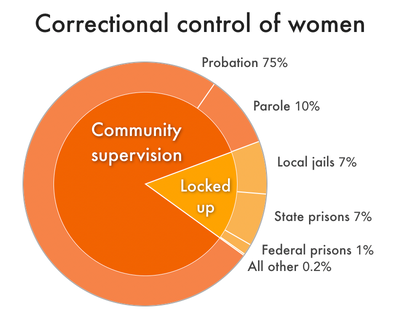
To avoid double-counting, any woman with more than one status was included in the most restrictive category, with probation counted as the least restrictive and imprisonment as the most restrictive. Percentages do not total 100% due to rounding.
Three-quarters of women (75%) under the control of any U.S. correctional system are on probation. Probation is often billed as an alternative to incarceration, but instead it is frequently set with unrealistic conditions that undermine its goal of keeping people from being locked up.19 For example, probation often comes with steep fees, which, like bail, women are in the worst position to afford.20 Failing to pay these probation fees is often a non-criminal “technical” violation of probation. Childcare duties further complicate probation requirements that often include meetings with probation officers, especially for women with no extra money to spend on childcare or reliable transportation across town. And probation violations — even for these innocuous and understandable reasons — can land women in jail or prison who were never sentenced to incarceration. In fact, our analysis of the 2016 Survey of Prison Inmates found that one-third (33%) of women in state prisons were on probation at the time of their arrest, which underscores how this “alternative to incarceration” often simply delays incarceration.
In the wake of the 2022 Supreme Court decision to overturn Roe v. Wade, restrictive probation and parole conditions can also create barriers to accessing reproductive health care. Restrictions on travel are “standard conditions” of supervision in many places, requiring approval from a probation or parole officer to make specific trips. With many states now banning (and trying to criminalize) abortion, seeking abortion care may be difficult or impossible for many of the hundreds of thousands of women on probation or parole in those states.
Reentry is another critical point at which women are too often left behind. Almost 2.5 million women and girls are released from prisons and jails every year,21 but few post-release programs are available to them — partly because so many women are confined to jails, which are not meant to be used for long-term incarceration. Additionally, many women with criminal records face barriers to employment in female-dominated occupations, such as nursing and elder care.22 It is little surprise, therefore, that formerly incarcerated women — especially women of color — are also more likely to be unemployed and/or homeless than formerly incarcerated men, making reentry and compliance with probation or parole even more difficult. All of these issues make women particularly vulnerable to being incarcerated not because they commit crimes, but because they run afoul of one of the burdensome obligations of their probation or parole supervision.
The need for more data
The picture of women’s incarceration is far from complete, and many questions remain about mass incarceration’s unique impact on women. This report offers the critical estimate that a quarter of all incarcerated women are unconvicted. But — since the federal government hasn’t collected the key underlying data in almost 20 years — is that number growing? And how do the harms of that unnecessary incarceration intersect with women’s disproportionate caregiving to impact families? Beyond these big picture questions, there are a plethora of detailed data points that are not reported for women by any government agencies, such as the simple number of women incarcerated in U.S. territories or involuntarily committed to state psychiatric hospitals because of justice system involvement.
As public awareness has grown about the differences between gender identity and sex assigned at birth, there has been a growing interest in the question of how transgender and nonbinary individuals experience incarceration. Unfortunately, government surveys that break down data between "male" and "female" categories often include trans men among "females" and trans women among "males," relying on housing assignments as a proxy for gender. This further muddies the picture of women's incarceration.
While more data is needed, the data in this report lends focus and perspective to the policy reforms needed to end mass incarceration without leaving women behind.
Get our latest data & analysis in your inbox!
About the data
This briefing uses the most recent data available on the number of people in various types of facilities and the most significant charge or conviction. Because not all types of data are collected each year, we sometimes had to combine differing data sets; for example, we applied the percentage distribution of offense types from the previous year to the current year’s total count data, since prison offense data lags by one year. To smooth out these differing levels of vintage and precision among the sources, we choose to round all figures in the graphic. This process may, however, result in various parts not adding up precisely to the total.
- Jails: Calculated based on the Bureau of Justice Statistics report Jail Inmates in 2021, Table 2 (as of June 30, 2021). The Bureau of Justice Statistics has stopped collecting data on the conviction status of women in jails in 2005, so we calculated the breakdown based on the 2009 estimate (the most recent available) published in the Jail Inmates at Midyear 2013 — Statistical Tables. Our analysis of offense types is based on the Survey of Inmates in Local Jails, 2002. See below and Who is in jail? Deep dive for why we used our own analysis rather than the otherwise excellent Bureau of Justice Statistics analysis of the same dataset, Profiles of Jail Inmates, 2002. While this methodology section illustrates the pervasive dearth of women’s criminal justice data, this 2002 data continues to be the most recent data available of its kind even without regard to gender breakdown. (The Bureau of Justice Statistics was scheduled to start administering the next Survey of Inmates in Local Jails in 2018, but is now re-scheduled to 2024.)
- Immigration detention: The number of women in immigration detention, and what facilities they are held in, comes from from ICE’s Detention Statistics for FY 2023 (reporting average daily populations as of January 28, 2023, which includes the first four months of the fiscal year). We calculated the total average daily population from the reported numbers of “Female Crim” and “Female Non-Crim” in the “Facilities FY23” spreadsheet, and categorized them by facility type as follows: 1 woman held in a non-ICE federal facility (BOP), 339 in local jails (ISGA or USMS IGA), and 3,276 held in facilities that typically hold only ICE detainees (DIGSA, CDF, SPC, and Staging facilities). The 339 women held in local jails were then removed from the total jail population to avoid double-counting them. Because the federal BOP publishes population data by jurisdiction (as opposed to custody), the woman held for ICE in the BOP facility was already excluded from the federal prison population data.
- Federal: Bureau of Justice Statistics report Prisoners in 2021, Table 19, reports the percentage breakdown of offense types for the sentenced population as of September 30, 2020, and the total population of women reported in Table 2 for December 31, 2021. We applied the offense type percentages to the total population, but data do not exist for a good estimate of offense types for pretrial women under Federal control (i.e., those in the custody of the U.S. Marshals Service). We also attributed women held by the U.S. Marshal Service in state and local facilities to the total Federal slice, see the “data definitions and clarifications” section below for details.
- State prisons: Prisoners in 2021, Table 2 provides the gender breakdown for the total population as of December 31st, 2021, and Table 16 provides data (as of December 31, 2020) that we used to calculate the ratio of different offense types, which we then applied to the total state prison population as of year-end 2021.
- Military: The latest gender breakdown we could find was in Correctional Populations in the United States, 1998, Table 8.5, which reported the number of prisoners under military jurisdiction, by officer and enlisted status, gender, race, and Hispanic origin, for December 31, 1998. We calculated the number of women for our military slice by imputing the percentages from 1998 to the numbers reported in Prisoners in 2021, Table 23, which gives the number of people incarcerated in by each branch of the military, but does not provide a gender breakdown.
- Territorial prisons (correctional facilities in the U.S. Territories of American Samoa, Guam, and the U.S. Virgin Islands, and U.S. Commonwealths of Northern Mariana Islands and Puerto Rico): Estimates for the female populations were calculated based on the percentages of women reported in World Prison Brief data, which we then applied to the total populations reported in Prisoners in 2021, Table 25. The reference dates for the World Prion Brief data range from year-end 2007 (for the Northern Mariana Islands) to June 30, 2021 (for the U.S. Virgin Islands).
- Youth: Office of Juvenile Justice and Delinquency Prevention, Easy Access to the Census of Juveniles in Residential Placement, reporting data for 2019. We defined “youth confinement” to include all juvenile justice-related placements outside of the home. This methodology better reflects the realities of youth confinement and brings us closer to showing the full scope of confinement for all people in the U.S. The inclusion of these less restrictive forms of confinement for youth is consistent with our approach for the adult system which includes halfway houses and other forms of community confinement as a part of the entire adult system.
- Civil commitment (At least 20 states and the federal government operate facilities for the purposes of detaining people convicted of sexual crimes after their sentences are complete. These facilities and the confinement there are technically civil, but in reality are quite like prisons. People under civil commitment are held in custody continuously from the time they start serving their sentence at a correctional facility through their confinement in the civil facility.): The Sex Offender Civil Commitment Programs Network conducts an annual survey, and the civil commitment data came from an email with SOCCPN President Shan Jumper, estimating that there were 7 women total, nationally (based on the SOCCPN 2019 Annual Survey, the last year that data was collected). And according to the Common Questions about Civil Commitment as a Sexually Violent Person (Adopted by the ATSA and the Sex Offender Civil Commitment Programs Network Executive Boards of Directors on October 13, 2015), there are “a few women throughout the country who have been committed.”
- Indian country (correctional facilities operated by tribal authorities or the U.S. Department of the Interior’s Bureau of Indian Affairs): Bureau of Justice Statistics’ Jails in Indian Country, 2021, and the Impact of COVID-19, July-December 2020, Table 6, reporting data for June 30, 2021.
- Probation and parole: Our counts of women under community supervision are calculated from the Bureau of Justice Statistics report Correctional Populations in the United States, 2021, Table 5 (showing the total number of women on probation and the total on parole) and Table 11 (showing the estimated number of women who were on both probation and parole when the data were collected). To avoid double-counting those women who had dual probation and parole status, we reduced the total number of women on probation by 2,500 — counting them just once, within the total parole population. This is consistent with our past methodologies, in which we categorize those with dual status by their most restrictive status — counting parole as more restrictive, as people on parole are finishing carceral sentences in the community. For readers interested in knowing the total number of women on parole and probation, ignoring any double-counting with other forms of correctional control, there were 92,700 women on parole and 718,400 women on probation at the end of 2021 (the most recent year for which data are available).
Several data definitions and clarifications may be helpful to researchers reusing this data in new ways:
- To avoid double-counting women held in local jails on behalf of the Bureau of Prisons, ICE, U.S. Marshals Service, state, and other prison authorities from being counted twice, we removed the 8,875 women from the jail custody population reported by the BJS and from the numbers we used to calculate the number of convicted women in local jails. Our calculation for the number of women held in such arrangements was based on data reported for the total number of people held in jails for federal and state authorities in Table 8 of Jail Inmates in 2021, Table 14 of Prisoners in 2021, and the 2002 Survey of Inmates in Local Jails, where our analysis showed that about 8.5% of those held in such arrangements were women. Because the total numbers of people held in jails for each agency are not broken down by gender, we applied that ratio (8.5%) to the totals reported as held in jails for each agency except for ICE, to create estimates by gender. To estimate the most recent number available of women held in jails for ICE, we used ICE’s Detention Statistics for FY 2023 (reporting average daily populations as of January 28, 2023, which includes the first four months of the fiscal year). We calculated the total average daily population held in jails (339) from the reported numbers of “Female Crim” and “Female Non-Crim” in the “Facilities FY23” spreadsheet that were held in facilities designated as ISGA or USMS IGA.
- Because we removed ICE detainees and people under the jurisdiction of federal and state authorities from the jail population, we had to recalculate the offense distribution reported in Survey of Inmates in Local Jails, 2002 who were “convicted” or “not convicted” without the people who reported that they were being held on behalf of state authorities, the Federal Bureau of Prisons or U.S. Immigration and Naturalization Service/U.S. Immigration and Customs Enforcement (ICE). Our definition of “convicted” was those who reported that they were “To serve a sentence in this jail,” “To await sentencing for an offense,” or “To await transfer to serve a sentence somewhere else”. Our definition of not convicted was “To stand trial for an offense,” “To await arraignment,” or “To await a hearing for revocation of probation/parole or community release.”
- We also accounted for women held in federal pretrial detention who are confined in jails. We estimate 2,878 women held by, or for, the U.S. Marshals Service, using data from Jail Inmates in 2021, Table 8 (showing that 33,900 people were held in jails for USMS) and our analysis of the 2002 Survey of Inmates in Local Jails (showing that 8.5% of those held for other agencies were female). We included these 2,878 women in the Federal prisons slice of the pie chart.
- Lastly, the youth slice does not include 252 girls held in adult jails and prisons. As of 2019 (the most recent year for which data are available on this point), there were 230 girls under the age of 18 held in local jails (reported in Table 6 of Bureau of Justice Statistics Census of Jails, 2005-2019), and 22 girls under the age of 18 held in state or federal prisons (as reported by the Bureau of Justice Statistics Quick Table, Reported number of female inmates age 17 or younger held in custody in federal or state prisons [XLS], December 31, 2000-2019).
Footnotes
-
This is most powerfully illustrated in our work comparing individual states’ incarceration rates to other countries. See also the underlying data. ↩
-
Even the available data that are disaggregated by sex are frustratingly limited, in that they typically only differentiate between “male” and “female,” ignoring the reality that the gender identities of confined people (and all people, for that matter) are not limited to this binary. The Bureau of Justice Statistics has begun to collect data on transgender and nonbinary individuals; for example, it reported data on a small sample of transgender individuals in state prisons in its 2016 Survey of Prison Inmates, which we analyzed. Meanwhile other non-government organizations such as the National Center for Transgender Equality are beginning to fill this data gap with large-scale surveys. For example, the U.S. Trans Survey asks respondents about recent experiences with policing, incarceration, and immigration detention. Although currently incarcerated individuals are not included in the sample, 2% of the respondents to the 2015 survey were incarcerated in the previous year. This field of research has a long way to go before the data are consistently collected and reported by gender identity rather than an administrative categorization of “male” versus “female.” The use of the terms “women” and “girls” in this report reflect these present data limitations. For more on the limitations of gender-specific data and how the current data misclassifies trans men and women, see the section of this report The need for more data. ↩
-
The Survey of Prison Inmates, last conducted in 2016 by the Bureau of Justice Statistics, provides the most recent nationally-representative, self-reported data about the people incarcerated in state and federal prisons, their backgrounds, and their experiences in prison. In our analysis of the data, we focused on state prisons, which account for a much greater share of the total incarcerated population, and wherever possible, we used the self-reported gender identity of respondents instead of the administrative sex variable, which was defined by whether the facility holding the respondent was a “women’s” or “men’s” prison. ↩
-
For example, our report The Gender Divide: Tracking Women’s State Prison Growth covers the effects of reform on women in prisons and the Vera Institute of Justice covers women in jails in their report, Overlooked: Women and Jails in an Era of Reform. ↩
-
Our research found that women who could not make bail had an annual median income of just $11,071 (in 2015 dollars). And among those women, Black women had a median annual income of only $9,083 (just 20% that of a white non-incarcerated man). When the typical $10,000 bail amounts to a full year’s income, it’s no wonder that women are stuck in jail awaiting trial. ↩
-
As we’ve written, other studies specifically looking at pretrial confinement confirm that women’s inability to afford bail has a particularly high impact on families. ↩
-
Moreover, while these data aren’t available nationally for local jails, we know that among people in state prisons, women report fewer prior arrests and incarcerations on average than men, suggesting that their criminal histories are less likely to contribute to a harsher sentence. ↩
-
A gender analysis of the Bureau of Justice Statistics’ Indicators of Mental Health Problems Reported by Prisoners and Jail Inmates 2011-12 report (the most recent available in this series) is available in our 2017 briefing New government report points to continuing mental health crisis in prisons and jails. And for anyone still unsure of the harms of jail, just look at the suicide rates in U.S. jails. ↩
-
The 2017 study based on the 2011-2012 National Inmate Survey (the most recent available) found that 42.1% of women in prison (state or federal) and 35.7% of women in jail are sexual minorities, compared to 9.3% of men in prison and 6.2% of men in jail. The study also confirmed that “[t]here is disproportionate incarceration, mistreatment, harsh punishment, and sexual victimization of sexual minority inmates.” Our more recent analysis of women in state prisons, which used data from the 2016 Survey of Prison Inmates, found that over 22% of women in state prisons report being lesbian or bisexual, compared to 2.5% of men who report being gay or bisexual. ↩
-
The women’s incarcerated population has a different race and ethnicity breakdown than the total U.S. population and total incarcerated population. It should be noted that these data are from our previous analysis of the 2010 Census data on people who were held in correctional facilities for adults (jails or prisons) at the time of the census count. While you might expect that the same data would be available from the 2020 Census, as of this report’s publication, the data necessary to update our analysis have not yet been released. However, newer data on the racial and ethnic identities of women in prisons (but not jails) are available from the Bureau of Justice Statistics: In state and federal prisons in 2021, 47% of women were white, 17% Black, 19% Hispanic, 2.5% American Indian or Alaska Native, 0.75% Asian, and 13.3% “other” (women reporting two or more races and other groups not broken out). ↩
-
These disparities don’t stop at incarceration. Even once released, women are at greater risk for homelessness and unemployment, with Black women being hit hardest. Additionally, our 2019 report Policing Women: Race and gender disparities in police stops, searches, and use of force found significant racial disparities in arrest rates for women (but not men) in police-initiated traffic and street stops. We found that white women were about half as likely as white men to be arrested during a stop, but Black women were at least as likely as white men to be arrested. Black women were arrested in 4.4% of police-initiated stops, which was roughly three times as often as white women (1.5%), and twice as often as Hispanic women (2.2%). ↩
-
Additionally, more than 20% of girls in youth confinement are held for non-criminal or “technical” violations of probation, compared to less than 13% of boys. ↩
-
In our recent analysis of the 2016 Survey of Prison Inmates dataset, only one-third (33%) of people in state prisons reported any visits with their minor children while in prison. When asked why their children hadn’t visited them in prison, parents most frequently blamed the distance from the prison (33%). ↩
-
It may seem like 2016 data about prison populations would be outdated by now, but because this survey takes a much deeper look into pre-incarceration life experiences, these data remain essential to understanding incarceration today. Moreover, the Bureau of Justice Statistics does not conduct this survey very often; before 2016, it was last fielded in 2004. ↩
-
The Bureau of Justice Statistics has published its own reports that include findings about people in both state and federal prisons; however, these reports are generally not as detailed as our own analysis. You can read our in-depth analyses of the data in the following reports and briefings: Beyond the Count: A deep dive into state prison populations, Chronic Punishment: The unmet health needs of people in state prisons, Both sides of the bars: How mass incarceration punishes families, The state prison experience: Too much drudgery, not enough opportunity, and What the Survey of Prison Inmates tells us about trans people in state prison. ↩
-
For more information about pregnancy and prenatal care in correctional settings, see the Pregnancy in Prison Statistics (PIPS) project, spearheaded by Dr. Carolyn Sufrin of the Johns Hopkins University School of Medicine and Public Health. For an introduction to this work, see our discussion of some of the findings from that project. ↩
-
Data from the 2016-2018 Survey of Sexual Victimization show that while women made up just 10% of the combined prison and jail population at the time, they accounted for 27% of all victims of staff sexual misconduct and sexual harassment. (See table 10 of the Bureau of Justice Statistics’ 2023 report Substantiated Incidents of Sexual Victimization Reported by Adult Correctional Authorities, 2016-2018.) ↩
-
Marginalization, trauma, mental health problems, and self-medication with drugs and/or alcohol are recurrent themes in studies of incarcerated women. A previous Bureau of Justice Statistics study found that, of the women in state prisons who have mental health problems, three-quarters also met the criteria for substance dependence or abuse, and more than two-thirds (68%) had a history of physical or sexual abuse. Another study of women in jails found that 98% had experienced trauma in their lifetimes. For more context about women in prison, see the sidebar Context: What’s behind women’s prison growth? in our report The Gender Divide. ↩
-
Probation also varies wildly between states. ↩
-
Reporting from the New York Times, Probation May Sound Light, but Punishments Can Land Hard, captures the typical cascading fees and conditions while following one woman’s navigation of probation. ↩
-
In 2019, approximately 2,450,379 women and girls were released from adult correctional facilities. According to data from the National Prisoner Statistics program, 71,655 women were released from state prisons and 4,738 were released from federal prisons in 2019. And according to data from the 2019 Census of Jails, about 2,373,986 women and girls were released from local jails nationwide that year. The related, linked 2019 briefing used older data from the same data collections, which explains the difference in the estimated number of releases. ↩
-
A recent law review article on the use of record clearance and expungement mechanisms notes that “several studies have found that women represent almost 50 percent of those seeking records clearance, as compared to approximately 25 percent of those arrested, due potentially in part to the desire of women to enter ‘caregiving’ fields such as nursing and geriatric care, whose licensing requirements often bar individuals with criminal records. This suggests that criminal records act as a particular impediment to women….” ↩
Acknowledgements
The Prison Policy Initiative would like to thank the ACLU Campaign for Smart Justice for their partnership over the years in producing the Women’s Mass Incarceration: The Whole Pie report series. The organization also thanks the MacArthur Foundation’s Safety and Justice Challenge, and all of the donors, researchers, programmers and designers who helped the Prison Policy Initiative develop the Mass Incarceration: The Whole Pie series of reports.
About the authors
Aleks Kajstura is Legal Director at the Prison Policy Initiative. She directs the organization’s campaign to end prison gerrymandering (the practice of using prison populations to distort democracy via redistricting). Aleks has also published several reports on women’s incarceration, including previous versions of Women’s Mass Incarceration: The Whole Pie, and States of Women’s Incarceration: The Global Context, which compares the rate of women’s incarceration in every U.S. state to 166 independent countries.
Wendy Sawyer is the Research Director at the Prison Policy Initiative. Along with helping direct the organization’s research priorities, Wendy is the author (or co-author) of several major reports, including Mass Incarceration: The Whole Pie, Beyond the Count: A deep dive into state prison populations, All Profit, No Risk: How the bail industry exploits the justice system and Arrest, Release, Repeat: How police and jails are misused to respond to social problems. Wendy also frequently publishes briefings on recent data releases, academic research, women’s incarceration, pretrial detention, probation, and more.
About the Prison Policy Initiative
The non-profit, non-partisan Prison Policy Initiative was founded in 2001 to expose the broader harms of mass criminalization and spark advocacy campaigns to create a more just society. Through big-picture reports like Mass Incarceration: The Whole Pie, as well as in-depth reports on issues such as medical neglect behind bars and bail reform, the organization helps the public more fully engage in criminal justice reform. The organization also launched, and continues to lead, the national fight to keep the prison system from exerting undue influence on the political process (a.k.a. prison gerrymandering).
About the ACLU Campaign for Smart Justice
The ACLU’s Campaign for Smart Justice is an unprecedented, multiyear effort to cut the nation’s jail and prison populations by 50% and challenge racial disparities in the criminal justice system. The Campaign is building movements in all 50 states for reforms to usher in a new era of justice in America.

This report is licensed under a Creative Commons Attribution-NonCommercial 4.0 International License.
Events
- April 15-17, 2025:
Sarah Staudt, our Director of Policy and Advocacy, will be attending the MacArthur Safety and Justice Challenge Network Meeting from April 15-17 in Chicago. Drop her a line if you’d like to meet up!
Not near you?
Invite us to your city, college or organization.
